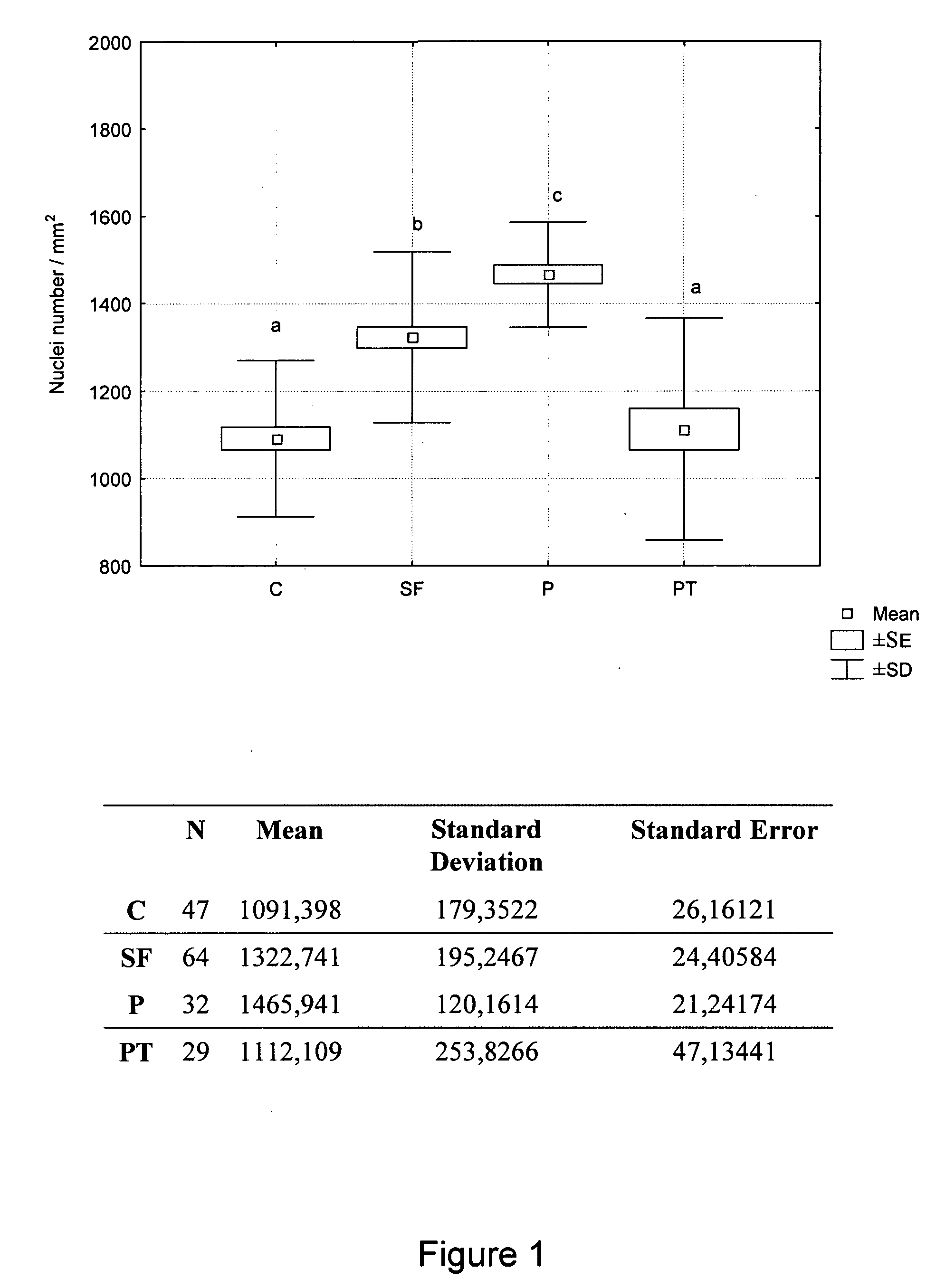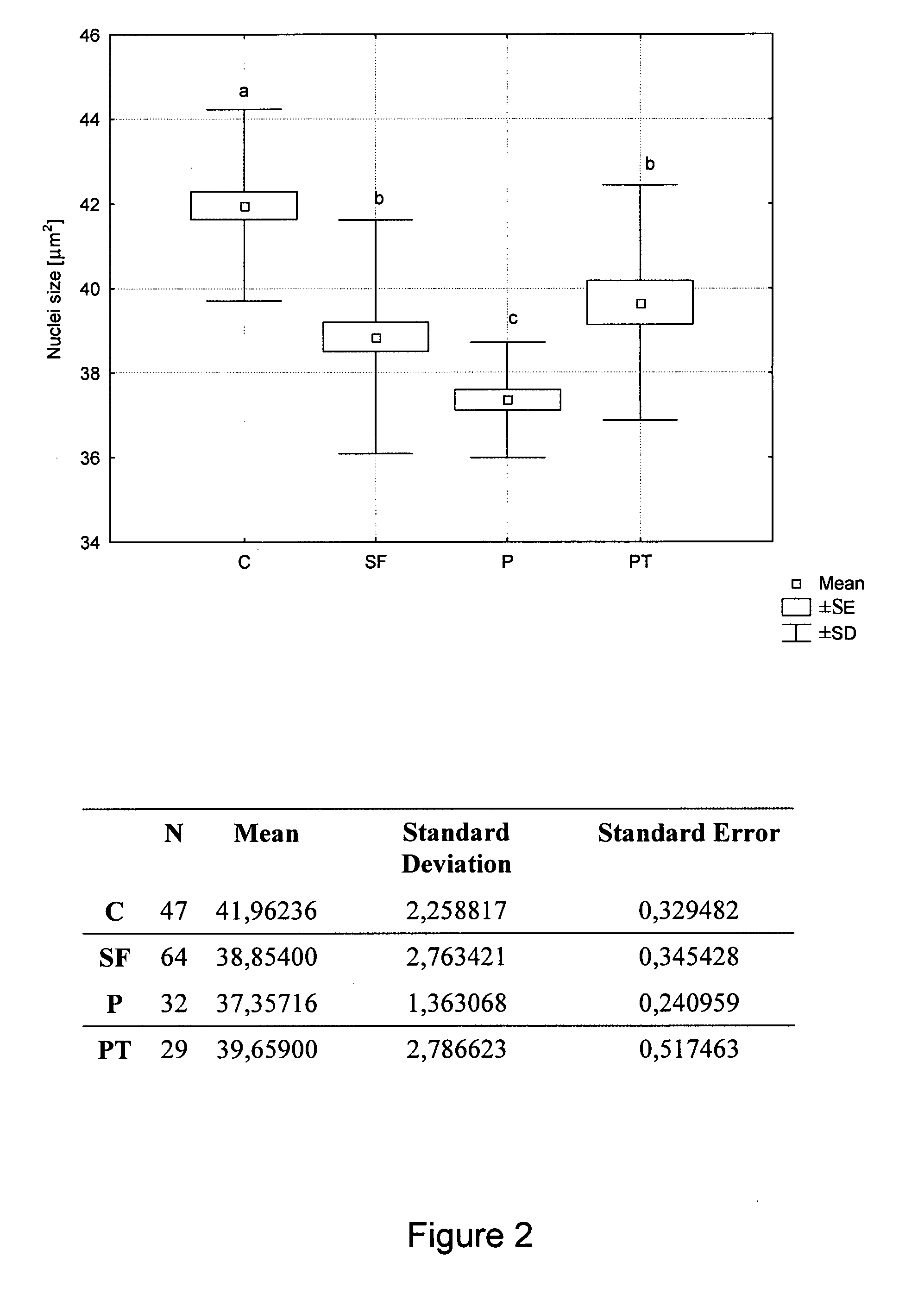Heat processed vegetabilic fiber preparation and its use as inhibitor of the effects of carcinogenic substances in humans or animals
a technology of vegetabil fiber and cellulose, which is applied in the direction of biocide, plant/algae/fungi/lichens, drug compositions, etc., to inhibit the development of neoplasma (neoplastic growth) and inhibit the effect of effects
- Summary
- Abstract
- Description
- Claims
- Application Information
AI Technical Summary
Benefits of technology
Problems solved by technology
Method used
Image
Examples
example 1
[0068]The main aim of these studies was to see if a potato fiber supplemented diet had any effect on acryl amide induced cancer development in mice.
Laboratory Animals
[0069]Seventy five 9-weeks old male and seventy five 7 to 9 weeks old female BALB mice (Laboratory), weighing about 20 g, were used. Mice were housed ten per box of the same sex. Solid food and water were allowed in sufficient quantities. The animals were kept in an animal house where the humidity and temperature were controlled and where a 12 h light period was kept. The experiment has been reviewed and approved by Lund University ethic committee, application M140-03.
Experimental Food / Feed
[0070]The experimental feed was provided by WYTWORNIA PASZ I (Feeds and Concentrates Production Plant, Certificate of Quality System No 181 / 1 / 98, Kcynia, Poland).
[0071]Three types of formulated mixtures were manufactured:
[0072]1 / Labodiet MLF control. The receipt of this food / feed is based on the energy needs according to the Polish n...
example 2
Anticancer Activity of Fractions of a Potato Fiber Preparation
[0090]The aim of the study was an in vitro evaluation of anticancer activity of water extracts obtained from Potex. The following extracts were prepared: basic (1o), acidic (2o), non-treated-control (3o), autoclaved (4o) and dry heated 170° C. (5o). At first the antiproliferative activity of all extracts was assessed in two cancer cell lines: colon carcinoma (HT-29) and breast carcinoma (T47D). Next experiments were focused on 5o fraction. The antiproliferative activity of this fraction was assessed in 4 tumor cell lines (HT-29, T47D, TE671 (rhabdomyosarcoma / medulloblastoma) and C6 (glioma) by means of MTT method. In the further series of experiments, the 5o fraction was evaluated to characterize the mechanisms involved in their anticancer activity. The influence on DNA synthesis was assessed by means of BrdU incorporation into DNA during tumor cell division. The apoptotic tumor cell death was dete...
example 3
The Effect of Heating Exposure Time on Antiproliferative Activity
[0118]To evaluate the influence of heating time on anticancer activity, Potex was heated at 170° C. for 0.5, 1 and 2 h and three extracts (A, B and C) were prepared as described above. MTT assay revealed that extract obtained after 2 h heating was the most effective as a TE671 cells growth inhibitor (FIG. 24).
Concluding Remarks
[0119]Tested extracts express an antiproliferative activity in tumor cells[0120]The antiproliferative effect of heated fraction was attributed to decreased DNA synthesis and resulted in apoptotic cell death[0121]Heated fraction inhibits tumor cell motility[0122]Heated fraction induces marked changes in tumor cell morphology[0123]Heated fraction in anticancer concentrations is not toxic to normal cell cultures Antiproliferative effect of Potex depends on heating time, but always shows some effect.
PUM
 Login to View More
Login to View More Abstract
Description
Claims
Application Information
 Login to View More
Login to View More - R&D
- Intellectual Property
- Life Sciences
- Materials
- Tech Scout
- Unparalleled Data Quality
- Higher Quality Content
- 60% Fewer Hallucinations
Browse by: Latest US Patents, China's latest patents, Technical Efficacy Thesaurus, Application Domain, Technology Topic, Popular Technical Reports.
© 2025 PatSnap. All rights reserved.Legal|Privacy policy|Modern Slavery Act Transparency Statement|Sitemap|About US| Contact US: help@patsnap.com



